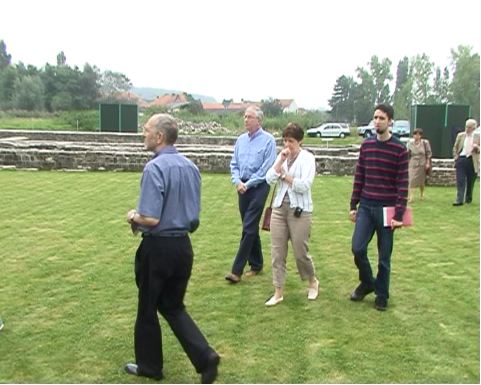

We see people coming together to visit the open-air exhibition of contemporary art "Ename Actueel" in Belgium. Would you like to talk about the atmosphere and what spectators might expect from the event that took place there?
Ename is a small town in Flanders in Belgium, with an archaeological site and an archaeological museum. They invite curators - each year a different one - to make a group show of contemporary art on the ancient ground. Moreover, the shows are supposed to re-actualize the site, creating new relationships between the history and the present. In Belgium, this kind of summer exhibitions are quite popular and appreciated by a heterogeneous public. The pictures that you see were all shot during the opening ceremony of this year's exhibition. Each artist could present a work in one of the green pavilions that were constructed especially for this purpose. Nevertheless I wanted to realize my work outdoors.
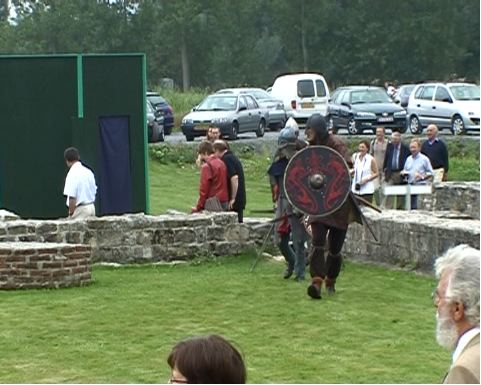
Vikings are entering the walled ground. They look aside, in a short aberration of their quick and furious arrival. It is, indeed, a remarkable coincidence: The ancient area with contemporary art in the background, furthermore the re-viewed past in the shape of ancient warriors acting as "themselves" but also as contemporary performers, if I might say so. Isn't it a bit confusing to go beyond - or to let the Vikings mime - the genuine concept of the art exhibition, offering a shift into a folk live show?
It might well be confusing to mix these different fields, but that is one of the main interests I had in doing this project. In many ways I find ‘folk live performances’ very interesting. The people who are involved in these activities have a passionate hobby that seems very anachronistic, but it also deals with our relationship to history and the difficulty how to re-interpret history. Mostly these activities become a mixture of contemporary culture and historical speculations.
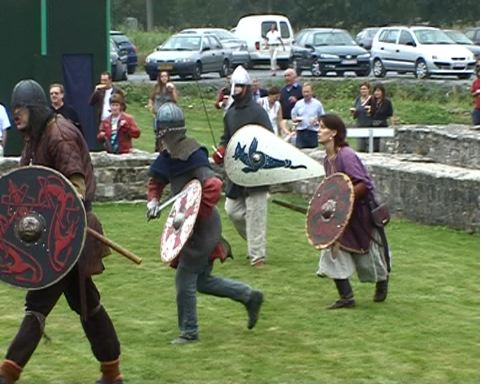
We see them speeding up, starting their attack - boasting their painted shields and seemingly authentic costumes; a woman is among them. It must have been an absolutely horrible feeling to watch real Vikings, a thousand years ago… They were feared because of their uncompromising brutality. Do you think that the public might have felt something of that as well? Or do you suggest any relationship between Vikings and the contemporary art world? I presume it was fun for the audience to experience this action?
I don’t think that the public had any horrible feelings, mainly because they were a public - and no victims of this attack. And I certainly wouldn’t honour the art world by comparing it to the ferocity of Vikings! I was interested in creating a moment of confusion, where the public would be doubting for a moment on their own position and on the attitude they should take in respect to this intrusion in the programme. The curator of the exhibition, Michel Dewilde, kept my intervention as a secret, so the public was confronted with the Vikings as a surprise. I think the way the people present perceived this action varied a lot, depending on their background. I also noticed that some of the ‘officials’ of the event looked quite disturbed during the performance and were searching for an explanation in the exhibition catalogue… Other people probably enjoyed it as a kind of theatre play without necessarily questioning it that much. I think that even though most of the people had fun observing the action, they were a bit confused or maybe a bit pissed as well… Nobody came to speak with me about the action afterwards.
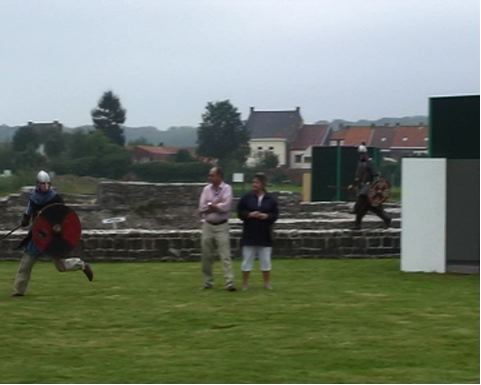
The past and the present are mixed up in a short play… Do you think that this kind of theatrical event or imagination can be regarded as interesting art?
I think that my intervention here is not only limited to the actual performance of the Vikings. It is much more working with the format and the concept of the exhibition itself. In order to understand my work it is necessary to consider it also with regard to the exhibition, not only to the performance. This is not an excuse – it is a fact that is due to the evolution of contemporary art and to the increasing focus on exhibitions instead of individual works or artists. This also leads to the increasing importance of curators. As an artist I do not wish to be a mere ingredient in the curators’ soup, so this makes me work more consciously with the exhibition format itself, positioning myself a bit 'outside' in order to be more able to grasp the exhibition itself as my material for work.
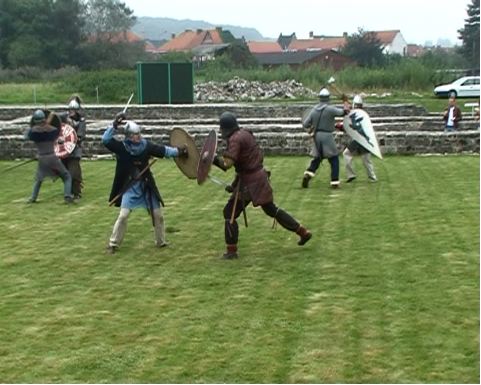
Looking at these fighters, let me ask, what's the difference between a historical performance and a contemporary artwork, and in which actual moment does the show switch from being an amateur performance, becoming your work?
As I explained before, my work does not only consist of the actual performance. It is also not only to be considered ‘within the exhibition context’. I see it as an intervention that uses the exhibition as a playground – and that should be a very natural attitude of all artworks and artists, I believe. In this case the curator knew about my work and encouraged it, because it was adaptable to his concept and served the exhibition, making it more interesting. But to come back to your question: Personally, I think that the performance can be seen as some kind of bad theatre. This doesn’t make it less interesting for me, though. The amateurish and improvised character does appeal to me very much. Nevertheless, I am not sure if I am allowed to – or if I should – have a claim on the performance as my own work. There is a gap between the idea and the realization that I do not fully understand yet. But I slightly enjoy this gap, which is the result of a certain lack of control for my part. This lack of control enables the people involved in the work to feel quite free, but it also creates a kind of uncertainty of what the performance is about. In that respect my work embraces this gap. The final form of the action and its esthetics are pretty much out of my control. It might seem inconsequent to work like this, but I think it is a real quality of my work. I enjoy discovering and sharing the esthetics of the people I work with.
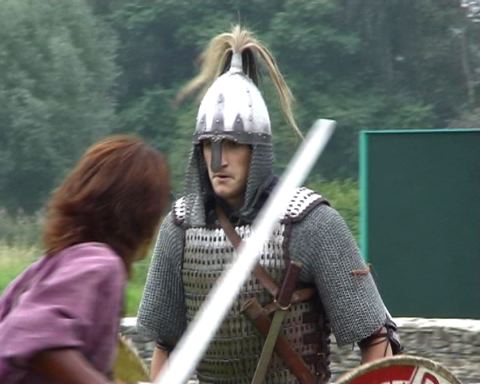
The Vikings were invited to perform one day before they would participate in a local festival of historical battles. They performed at your request within the context of the contemporary exhibition. Could you tell us something about the preparation of this work? You actually didn't ever watch the Vikings before the opening, did you?
Yes, I’m a bit ashamed to admit that I was only in e-mail contact with their ‘leader’, describing what I expected from them and how long the action should last. All the practical arrangements were made by the organizers of the exhibition: the curator Michel Dewilde and Marie-Claire Van der Donckt, conservator at the archaeological museum in Ename. I just arrived to the exhibition opening with my camera and talked about ten minutes with the Vikings before they got dressed. There were two other cameramen who I shortly instructed, Hubert Declercq and André Fernande, two friends of Michel Dewilde. Michel had the bright idea to ask them to come and film as well, and this was a fortunate circumstance because of the short, chaotic and unpredictable event that followed. Thanks to three different views it was possible for me to re-invent a clearer view on the action afterwards, through the video I made out of that material.
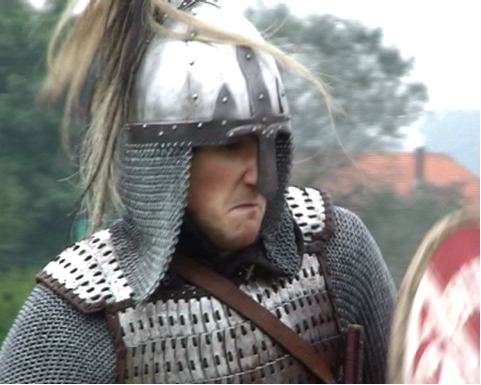
This fighter expresses a deep emotion I cannot fully understand; maybe of being exhausted or embarrassed, what do you think?
I think that he was completely into the fighting and expressed some uncontrollable facial emotions that you can observe in sports and sex, for example. These are very beautiful phenomena and I enjoy watching them. Another fact that I found interesting was that this Viking’s girlfriend also took part in the performance. They were actually fighting against each other. At the end she killed him.
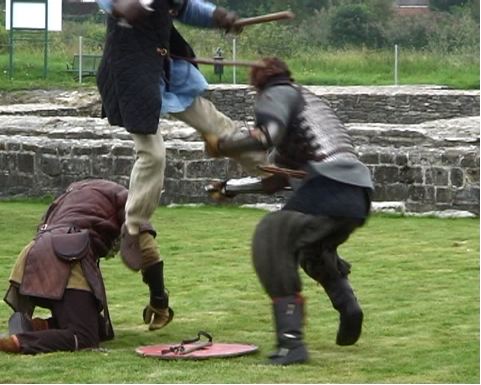
Do you think fake Vikings can tell us something about the world we live in? I mean, there must have been something that impelled you to invite them. Or should I imagine you draw a direct line from art to life instead of creating an encounter between the ancient and the present?
I do not think that fake Vikings can tell us much about the world we live in, but these are people who live in our world and who manifest a desire for something that modern society cannot offer them. This interests me more than the fight itself.
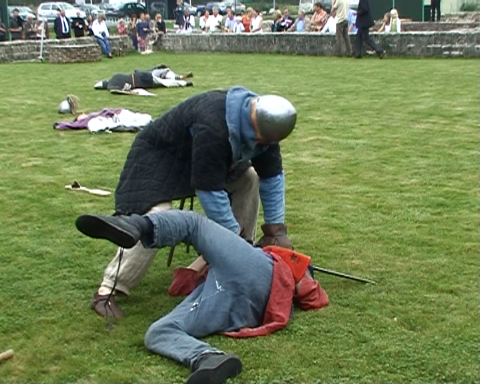
You said they are amateurs. Where do they come from, how many are they, and what is the purpose of their historical show?
Well, they don't do this as their profession. I said that the performance had an amateurish and improvised character, which hasn’t necessarily anything to do with being an amateur or a professional. The seven Vikings are Dutch and they belong to different Viking-groups, which do not usually perform any historical shows. They meet up for battles, but these battles do not aim at reconstructing historical facts. It’s more a kind of technical sport and the battles last only for about a minute they told me. So they repeat the attacks several times but not in order to come closer to some historical idea, their aim is to exercise their technique and to have fun.

This picture gives some additional impression concerning the cruel fight, but why was it necessary to include it in your documentation?
I like it. As I said earlier, these two fighters are a real couple, so for me it was fascinating to see them in action as Viking enemies. This moment was the most cruel of the whole performance and the little girls in the public reacted quite intensively. That’s why I think it is important to show the picture.
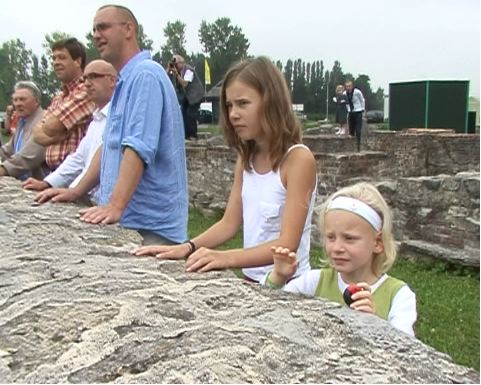
You didn't know the choreography, did you? And we didn't speak much about the filming yet. We have seen visitors walking within the battlefield, but most of them seem to stand behind the thick walls, which enclose the battlefield. The adults look quite pleased, but the girls don't. The little girl looks touched and innocent. There must be a difference between the adults' and the children's reaction to the fight. What was your impression?
For me the 'choreography' of the action was a total surprise. I was busy filming and I just tried to react to the action with my camera as well as I could. I tried to film the action from a distance, the second cameraman entered the battlefield while filming and the third cameraman was filming the public. At the beginning of the attack the visitors where mostly in the middle of the field, but they quickly gave place to the Vikings! Of course the perception and the reactions of the public depended on their age and their interpretation of the whole thing. To put it shortly, I guess the adults had a considerable distance to it while the children seemed more directly touched by the fight. I think this is just a normal phenomenon that we all know from watching TV, since we were children ourselves. I remember myself crying while watching westerns where the Indians always get killed. In this case the children didn’t cry, but they looked a bit disturbed. I should have asked them what they thought of it…
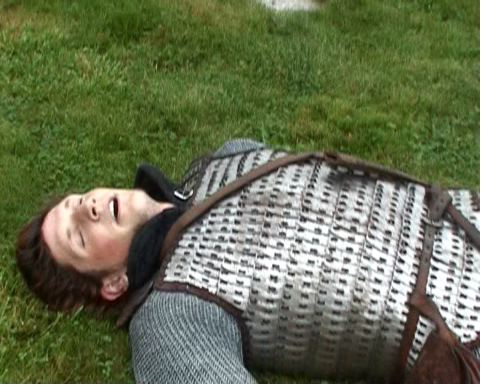
Do you see the pictures of the battle as a symbol for any dynamic, this one as 'death after the climax'? So that we can memorize the whole sequence as the documentation of a really dramatic event with a starting point and hot battle and an end in death without mourning, just as fresh and renewable as any stage performance after a pause, but without its demand on the actors' individual interpretation?
I think the whole action – as well as its context – was pretty ridiculous. And what I also liked was to try to catch some attempts of seriousness in the situation. And this reminds me of the fact that the Vikings actually performed two times at the opening: after the battle some people from the public wanted to see more, so the Vikings decided to perform a second fight at the request of the public... I was quite embarrassed at that moment but when I think of it afterwards, I feel that it was just what I had merited. And it meant that the public took back the power very quickly that I had challenged for a short moment. This was a good lesson for me, helpful in order to come up with some other ideas that will make it more difficult for the public to re-appropriate their position so easily. The ’manipulation’ of the public(s) seems to me an important issue in my artistic research – and by manipulation I don’t necessarily mean something evil. The relationship between an artwork and the public is a challenging subject for me to work on. Or rather the question of how to involve the public in a ’non-participative’ way...
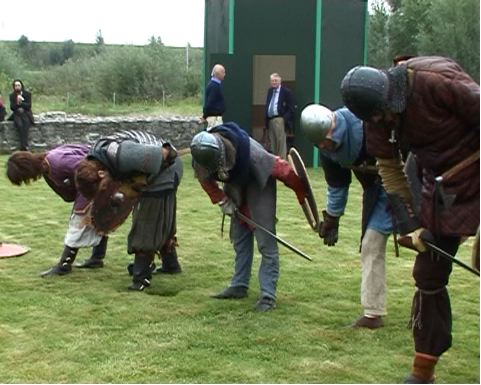
Eventually I would like to know if you think that the public did recognize this action as a contemporary art event, different from the battles the next day. Would you regard a former art experience on the part of the public as important? Is it your ambition to offer the audience more than fun and cheap attraction?
I’m convinced that not many people in the public have ever watched the kind of Viking battles that took place the next day. So I guess they couldn’t compare it to ‘my’ battle. And they shouldn’t really see the action as an artwork per se. The artwork was much more connected to the context of the exhibition and had more the value of an ‘intrusion’ in a wrong context. In that sense it was a bit pedagogical I guess, because its aim was to make the public reflect on the exhibition and on their position within this context. I had the feeling that people either liked it as a joke or that they felt pissed because they saw it as a critique of the whole exhibition. Of course both reactions are understandable but my ambitions are more indirect and I hope that some people also had some ‘second thoughts’ about the whole configuration of the exhibition.
Interview: Heike Wetzig & Kristofer Paetau, november 2005
A Quicktime Videodocumentation is to be viewed at:
http://www.paetau.com/downloads/VikingBattle/VikingBattle.mov